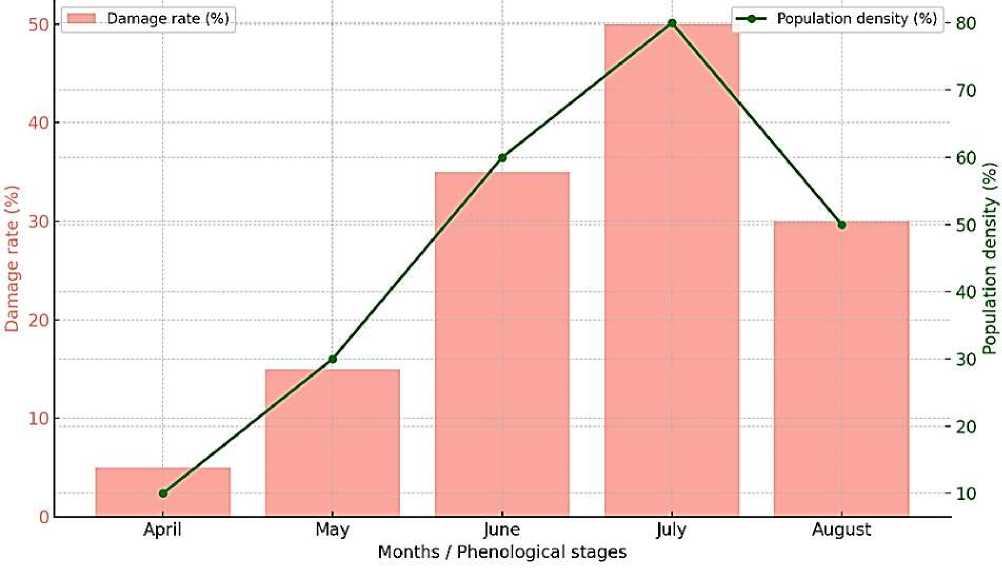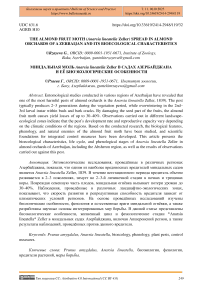The Almond Fruit Moth (Anarsia lineatella Zeller) Spread in Almond Orchards of Azerbaijan and its Bioecological Characteristics
Автор: Rzayeva G.
Журнал: Бюллетень науки и практики @bulletennauki
Рубрика: Сельскохозяйственные науки
Статья в выпуске: 10 т.11, 2025 года.
Бесплатный доступ
Entomological studies conducted in various regions of Azerbaijan have revealed that one of the most harmful pests of almond orchards is the Anarsia lineatella Zeller, 1839). The pest typically produces 2–3 generations during the vegetation period, while overwintering in the 2nd– 3rd larval instar within buds and bark cracks. By damaging the seed part of the fruits, the almond fruit moth causes yield losses of up to 30–40%. Observations carried out in different landscapeecological zones indicate that the pest’s development rate and reproductive capacity vary depending on the climatic conditions of the regions. Based on the conducted research, the biological features, phenology, and natural enemies of the almond fruit moth have been studied, and scientific foundations for integrated control measures have been developed. This article presents the bioecological characteristics, life cycle, and phenological stages of Anarsia lineatella Zeller in almond orchards of Azerbaijan, including the Absheron region, as well as the results of observations carried out against this pest.
Prunus amygdalus, Anarsia lineatella, bioecology, phenology, plant pests, control measures
Короткий адрес: https://sciup.org/14133949
IDR: 14133949 | УДК: 631.6 | DOI: 10.33619/2414-2948/119/32
Текст научной статьи The Almond Fruit Moth (Anarsia lineatella Zeller) Spread in Almond Orchards of Azerbaijan and its Bioecological Characteristics
Бюллетень науки и практики / Bulletin of Science and Practice
UDC 631.6
In recent years, Azerbaijan has entered a stage of rapid development in various branches of agriculture, including intensive horticulture. The area of almond orchards, which are of particular importance due to their economic and export potential, has been steadily increasing year by year. However, maintaining stable yields and improving quality indicators in orchards are limited by a number of phytosanitary problems. One of the main limiting factors is the intensive spread of pest insects. Almond Prunus dulcisis considered one of the main fruit crops of Azerbaijan and is widely cultivated, particularly on the Absheron Peninsula and in other subtropical zones of the country. Almond production has great economic importance both for local consumption and for increasing export potential.
There are several major reasons why almond plants are highly susceptible to pest infestations. Almond fruits serve as a rich energy source for pests, especially larvae and adult insects, which feed and develop inside the fruits. The buds, leaves, and fruit peels of almonds create an optimal environment for egg-laying and development of insects. At the same time, in subtropical zones such as the Absheron Peninsula, high temperatures and drought accelerate the reproduction of almond fruit moths. The large-scale cultivation of monocultures creates favorable conditions for the rapid spread of pests. Poor maintenance of plantations and insufficient preventive measures against pests increase the vulnerability of plants. Furthermore, the presence of other fruit or ornamental plants near almond orchards may contribute to the spread of pests.
Anarsia lineatella Zeller belongs to the order Lepidoptera, family Gelechiidae. It mainly attacks almond fruits, causing significant yield losses. Not only in its larval stages but also in the adult (imago) stage, the pest affects various plant structures. The almond fruit moth not only causes yield reduction but also has negative impacts on plant physiology and the overall health of the orchard.
Materials and Methods
Since 2024, research has been conducted in the almond-growing regions of Azerbaijan, including Shaki-Zagatala, Ganja-Gazakh, and particularly in the almond orchards of the Absheron Peninsula. In the selected stationary sites, the age, variety, and cultivation technology of almond trees were recorded. The climatic characteristics, soil type, and moisture level of the research areas were also observed.
Samples of the almond fruit moth at different developmental stages were collected weekly from April to September. Randomly selected branches of the plants were sampled and examined under a microscope in the laboratory. Samples of ripened fruits were collected, and the presence and activity of larvae were assessed in the laboratory. Adult pests were identified using sticky traps. To determine the life cycle stages of the pest, the periods of egg, larval, pupal, and adult stages were recorded weekly. The periods of activity for each stage were presented in a phenological calendar. The collected samples were kept on food substrates in the laboratory, where the pupation of larvae and emergence of adults from pupae were monitored. The duration of each stage and its variation depending on temperature were also recorded.
All experiments were carried out using standard methods accepted in entomology.
Results and Analysis
The adults measure approximately 7.5-13 mm in length. The forewings are steel gray in color with slight marginal projections, while the hindwings are lighter gray and more pointed than the forewings.
The eggs are oval-shaped, yellow or orange in color. The newly hatched larvae are white with a black head capsule. Mature larvae are brown, with alternating dark and light stripes along the abdomen; this characteristic distinguishes the pest from other larvae that damage stone fruits. The pupae are about 6.5-10 mm long. Pupation occurs in protected areas of the tree, and sometimes within the peduncle cavity of an infested fruit.
Observations have shown that Anarsia lineatella produces 2-3 generations per year. The first generation adults begin to emerge in late April, laying eggs on young shoots and developing fruits. The second generation was recorded in July-August, and in some regions, also in September. The pest primarily overwinters in the 2nd-3rd larval instar. Egg-laying occurs mainly from early April to mid-May on the young shoots and leaves of almond trees. Each female is capable of laying 50150 eggs. Larvae emerge within 7-12 days.
Larvae are active from mid-May to early July. They primarily feed inside the shoots and fruit pits, penetrating the seed and consuming it. At this stage, the greatest damage to the plant occurs, as larvae hollow out the seed, reducing both the quality and yield of the crop. The larval stage lasts for 3-4 weeks, after which pupation begins.
The pupal stage extends from early July to late August. During this period, the pest remains immobile but develops into the adult stage. From August to early September, the second generation adults emerge from pupae. They mate within a short period and begin oviposition. Adult activity is mainly observed in the evening and nighttime hours. Under the conditions of Absheron, Anarsia lineatella completes 2-3 generations per year.
Table
Phenological table of Anarsia lineatell a in Absheron, 2024
|
Months |
April |
May |
June |
Jule |
Agqust |
September |
October |
|
Dekdas |
I II III I |
II III I |
II III |
I II III |
I II III |
I II III |
I II III |
|
I |
+ + + + |
||||||
|
generation |
+ + |
+ + |
+ |
||||
|
• |
• • • |
• |
• • • •
II
generation
+ + + ++
• • ••
- - (-) (-) (-)(-)
Note: (-) — hibernating caterpillars; • — pupa; + — images; • — egg;--active larvae
As seen from the phenological calendar, based on research conducted in 2024 under Absheron conditions, Anarsia lineatella produces two generations during the vegetation period. The flight of the first-generation adults was observed in the 1st and 2nd decades of April, while egg-laying and larval emergence were recorded from mid-May onward. The development of the first generation primarily continued from the 3rd decade of May to the end of June. During this period, the larvae damaged young shoots, nuts, and newly forming fruits. From the second half of July, the adults of the second generation began to emerge. Egg-laying and larval activity were observed in August. The larvae of the second generation penetrated into the seeds during fruit maturation, reducing fruit quality and causing losses. From the end of September, the larvae entered the overwintering stage, hiding mainly under nut shells and flower buds, and entered diapause. This stage continued throughout October. Thus, phenological observations indicate that the main period of almond fruit moth damage in Absheron occurs in May-June (first generation) and July-August (second generation). Accurate monitoring of these stages is particularly important for the timely and effective implementation of control measures.

Figure. Population Density and Rate of Anarsia lineatella in Abscheron
The phenological table provides a basis for timely control of the pest. The control of Anarsia lineatella requires the application of agrotechnical, biological, and, when necessary, chemical methods. This pest damages both shoots and fruits in almond orchards, leading to a significant reduction in yield and quality. During autumn and winter pruning, dry, damaged, and curled shoots should be cut, removed from the orchard, and destroyed. Damaged fruits must be collected and eliminated in time, while fruit residues remaining under the trees should be cleaned. By applying optimal irrigation and fertilization practices, the resistance of trees can be enhanced. Parasitoid and predatory insects Trichogramma spp. and parasitoids belonging to the family Braconidae should be multiplied and released into the orchards. To capture males massively and reduce population density, pheromone traps should be installed. These traps are used both for monitoring and as a mass trapping method. Based on pheromone trap catches and phenological observations, the mass emergence of the pest should be determined, and insecticides must be applied accordingly. Spraying should be conducted when young larvae have just emerged from the eggs and before they penetrate into shoots or fruits.
Selective insecticides should be used against the pest, and chemical preparations must be rotated in order to prevent the development of resistance.
Conclusion
The results of the conducted research showed that the almond fruit moth (*Anarsia lineatella*) is widely distributed in almond orchards in Absheron and other regions of Azerbaijan. The population density and damage level of the pest vary depending on climatic conditions, phenological stages, and cultivation technology. The greatest damage was observed during fruit formation and maturation periods, resulting in significant yield losses.
The studies confirmed that timely detection of the almond fruit moth and understanding its biological characteristics allow for proper planning of integrated pest management measures. In controlling this pest, phenological monitoring, consideration of ecological factors, and the application of appropriate agrotechnical, biological, and chemical methods are of critical importance.
Practical Recommendations
It is necessary to conduct observations of the almond fruit moth’s developmental stages during the vegetation period in almond orchards. This will allow timely identification of the periods of mass population increase.
Timely collection and destruction of infested nuts and fruits, proper pruning, and maintaining cleanliness in orchards help reduce population density.
Conservation and augmentation of natural entomophagous organisms, as well as their artificial release, can be applied as effective measures against the almond fruit moth.
The installation of pheromone traps enables monitoring of pest population density and the establishment of an early warning system.
Chemical treatments should be used only when necessary, i.e., when the economic threshold is exceeded. When applying pesticides, preference should be given to environmentally safe, selective-effect preparations. Regular educational training for orchard owners and farmers can ensure effective control of the pest.


